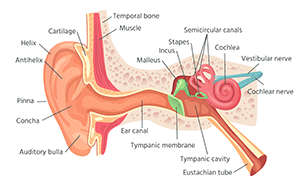Otology/Balance Dysfunction
 Otology is a subspecialty of Otolaryngology involving the medical treatment of the ears and hearing-related disorders. Our physicians have received specialized training in surgical cases that treat certain ear conditions. In some cases, medication can be an effective treatment. Based on the patient's diagnosis, our specialists will determine what treatment plan is most beneficial for the health and well-being of the patient. Some examples of the types of procedures/surgeries we preform are as follows:
Otology is a subspecialty of Otolaryngology involving the medical treatment of the ears and hearing-related disorders. Our physicians have received specialized training in surgical cases that treat certain ear conditions. In some cases, medication can be an effective treatment. Based on the patient's diagnosis, our specialists will determine what treatment plan is most beneficial for the health and well-being of the patient. Some examples of the types of procedures/surgeries we preform are as follows:Laser Stapedotomy
Laser ear surgery can treat a wide range of ear conditions with greater precision, less trauma and shorter recovery times than traditional surgery, and is effective in relieving symptoms and restoring hearing in patients of all ages. Using targeted laser energy, our physicians can treat hearing loss caused by otosclerosis or tumors in the ear, such as a cholesteatoma.
Otosclerosis involves the abnormal growth of bone in the middle ear, which prevents structures from functioning properly and can lead to hearing loss. The blocked ear structures are unable to vibrate in response to sound waves and therefore the ear cannot hear. This condition is acquired or hereditary, but may also be accelerated during pregnancy. Treatment for otosclerosis involves a procedure called a Laser Stapedectomy to bypass the abnormal bone and allow sound waves to travel through the ear.
Cochlear Implants
Individuals who are profoundly deaf or severely hard of hearing will benefit from cochlear implants. Different from hearing aids, cochlear implants directly stimulate the auditory nerve while hearing aids only amplify sounds. While use of a cochlear implant requires surgery and therapy to learn or relearn the sense of hearing, the implants can give a deaf person a useful representation of sounds in the environment and help the individual understand speech in person or over the phone.
Endoscopic Transcanal Ear Surgery
A minimally invasive technique, endoscopic transcanal ear surgery gives the surgeon the ability to access the middle ear through the ear canal without having to make an incision behind the ear and move the ear forward. Specially designed endoscopes are used to see and operate on the tiny, delicate structures within the middle ear. Any issues with the middle ear and/or ear drum should be checked by a specialist so these issues don't persist or destroy nearby healthy tissue, which can cause hearing loss, balance and facial movement. A condition commonly treated using this surgical technique is cholesteatoma, which is a collection of skin and dead skin cells in the middle ear that can become infected and spread into hidden recesses.
Eustachian Tube Balloon Dilation
When an individual has recurring internal ear pressure issues, this can lead to Eustachian Tube Dysfunction. A cold, sinus, nose or ear infection could result in temporary fullness or pressure in the ear. However, blocked eustachian tubes can be relieved by nasal sprays and antihistamine tablets, which reduce inflammation and congestion. Traveling on a plane can also cause internal ear pressure, although individuals are usually able to equalize the pressure in the ears themselves. For recurrent Eustachian Tube Dysfunction, surgical placement of the tubes called Eustachian Tube Balloon Dilation, may be performed to allow pressure in the middle ears to equalize.
Exostosis (Surfer's Ear) Surgery
Over time, chronic cold water exposure can cause benign bone growth causing a disease known as surfer's ear or external auditory exostoses. Surfer's ear can cause hearing loss, recurrent infections, otorrhea, a sensation of aural fullness, and cerumen impaction. If symptoms become severe, Exostosis surgery may be recommended.
Mastoidectomy
While ear infections can usually be treated with antibiotics, in rare cases medication fails. As a result, ongoing ear infections can cause complications of the inner ear leading to diseased mastoid air cells. Another complication of ongoing ear infections could result in the development of a skin cyst called cholesteatoma. At that point, a mastoidectomy may be recommended to treat this disease.
